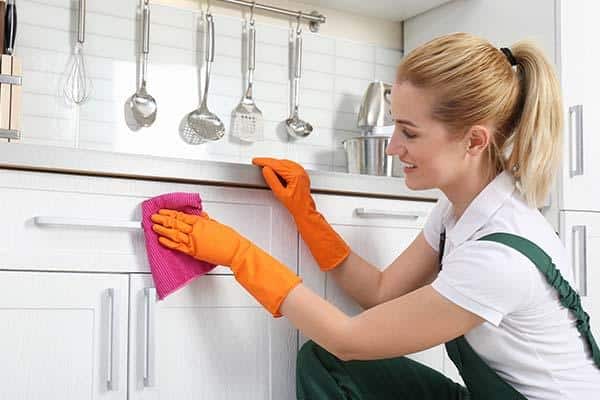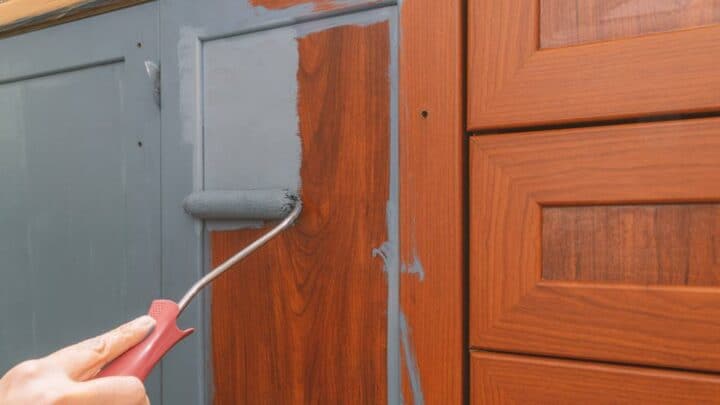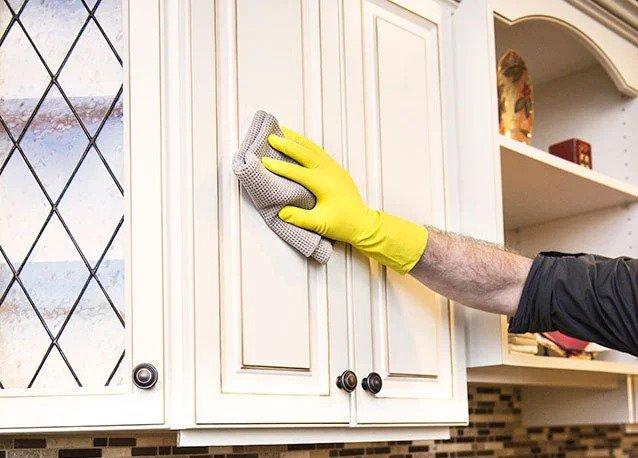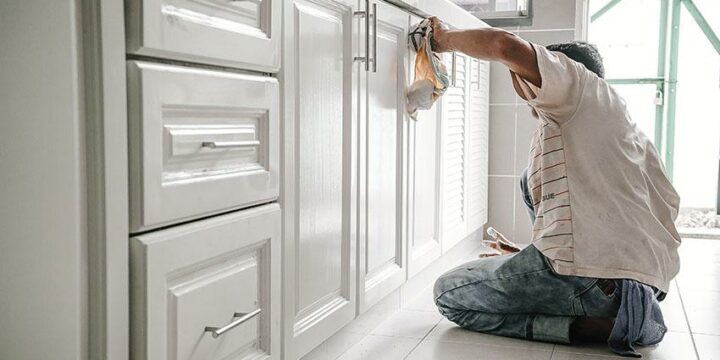Have you been noticing worn sports on your kitchen cabinets, and now you’re looking for ways to fix them? If so, then you’re definitely in the right place.
Fixing worn sports on kitchen cabinets is all about inspecting and finding out the spots. Then, you’ll need to fix them with the appropriate method and top them off with a coating of paint.
In this article, you’ll get to know all about how to fix worn spots on kitchen cabinets, how to bring your kitchen cabinets back to life, how to maintain your kitchen cabinets, and more. Continue reading to get all the answers.
Keep your kitchen cabinets spot-free
Kitchen cabinets are among the first few things that people notice whenever they step into a kitchen. These cabinets don’t just serve as storage for food items, spices, and utensils, but they also set the tone for the beauty and theme of your kitchen. Like any other part of your house, kitchen cabinets will not look new and spot-free forever. Plus, it doesn’t help that kitchens are normally the busiest and most hectic rooms in the house. It is normal for the wood to fade, the floor to get spots, and the kitchen cabinets to be worn out. Worn-out spots and marks will eventually arrive over time. Eventually, your kitchen cabinets might develop worn spots, dents, and ugly dings.
If you’re on the receiving end of this, you’ll probably be thinking about how to fix worn spots on kitchen cabinets?
The key to fixing worn spots on kitchen cabinets is to first conduct a visual inspection. This will allow you to see the issues and fully fix the cabinets. Look at the kitchen cabinet thoroughly. Look for any peeling, chips, dents, stains, or worn-out marks. Before you begin fixing anything, clean the kitchen cabinet with a damp cloth. You could even apply a wood cleaning solution to remove any dirt or grime. This will make it clearer to see any spots and imperfections in your cabinet.
How to fix worn spots on kitchen cabinets?
Fixing worn spots is a fairly straightforward task and will require a few basic tools and moderate elbow grease. The entire process starts with a visual inspection before you start cleaning and repainting or restraining the cabinets. Here are all the steps you need to follow for fixing worn spots on kitchen cabinets.
Check your kitchen cabinets thoroughly
Firstly, you must identify what your kitchen cabinets are made up of. Different materials will have different responses against damaging elements. While most kitchen cabinets are made up of wood, there is a wide variety of wood types. Each wood type will have different tolerances and reactions to water, physical impact, light, or temperature.
For instance, hardwood is more prone to discoloration. Meanwhile, particleboard easily sag, and plywood warps, which makes the kitchen fixture susceptible to dents. You should continue the visual inspection by looking for chips, peeling, nicks, water damage, or any other issue. After your thorough assessment, you will be able to better gauge the issues and the extent of treatment needed.
Clean the kitchen cabinet
Clean off any dirt and grime from your kitchen cabinets using a clean, damp cloth. Allow the cabinetry to dry properly before you move forward. This process will bring any imperfections further into the light such that you can treat them properly. It’ll also make touching up the areas much easier. After cleaning, you’ll have a more precise and accurate assessment of your kitchen cabinet’s state. The condition of the cabinet will dictate the tools and equipment you’ll need for resolving the issues.

Gather the tools needed for the job
The things that you’ll need to fix your kitchen cabinet will more than likely already be in your toolbox. If it isn’t, you can simply buy the tools at a nearby hardware store. If you see any minor scuffs on the cabinet, you can simply use a touch-up marker for covering them up. Ensure that you select the same color or a very similar shade as the kitchen cabinet. For heavier wooden spots or discoloration, you might need to sand down the worn spots. You might even have to do this for the entire cabinet if needed. The panels’ old finish, if any, needs to be removed such that new finishes will adhere better.
You’ll have to make use of fine, medium sandpaper, safety glasses, gloves, a tack cloth, and a respirator mask. Then, you should follow these simple steps.
- Choose a ventilated area to do the work. Make sure that you’re wearing the necessary protective equipment.
- If possible, you should remove the door handles or other accessories that might get in the way when sanding.
- Sand down any work spots using medium-grit sandpaper. Depending on the condition of the kitchen cabinets, you could prefer to sand one or all the surfaces evenly.
- Smoothen all the surfaces using fine-grit sandpaper.
- Wipe all the dust away using a clean tack cloth.
- You can use a polisher or a buffer if you’re looking to give the cabinets a smooth surface. It would be best to have no trace of the old finish for the next steps to work better.
Apply high-quality putty if needed
Cracks, dents, and gouges are fairly common when it comes to kitchen cabinets. As long as the damage isn’t structurally weakening the cabinet panel, you can try and remedy it. Your goal should be to fill in any gaps such that it levels with the wood surface. For small gauges, simply use putty sticks and then allow them to dry for a few days before finishing. For larger hopes, you can go for either putty or wood filler.
Wood putty will behave like clay, and it is easy to apply over a large area. Moreover, it is extremely durable and easy to afford. However, it does stay wet for a while and can extend the time timeline of your work for a few days. Wood filler, on the other hand, dries far more quickly. Moreover, it has large coverage, although, it does shrink or expand under extreme temperatures. Once you’ve filled the gaps, you’ll be able to sand the areas again for ensuring a totally level surface.
Apply new paint or stain
Once you have a level surface, you’ll be in a position to apply a new coating of paint or stain. Apply it using a paintbrush over the spots that you’ve just fixed. Make sure that you’re matching the existing color of the kitchen cabinet. It would be even better if you do a total refurbishment, as you’ll get a uniform pigment on all sides. Let the first coating dry, then assess the situation before adding a second coating (if needed).
Apply a polyurethane coating to finish
Lastly, you should apply a layer of polyurethane over the fixed spot or the entire cabinet using a paintbrush. The polyurethane coating will protect the cabinets from various causes of deterioration like water damage and abrasion. Apart from durability, polyurethane coating will also give the wooden surfaces a smooth, glossy finish, contributing to them looking new.
How to fix any scratches or spots on wood cabinets with paint?
Scratches and spots on wood kitchen cabinets are inevitable. Although this is minor damage, these spots and scratches are noticeable, and they’ll make your kitchen look aged. In some cases, the scratches that you’ll find may just be a wax build-up. You can remove them with ease using wax remover solvents or a homemade mixture of vinegar and tartar cream. For actual scratches, you might require a bit more than a solvent. You will need to cover up the scratches with paint or pigment that matches perfectly to the rest of the kitchen cabinet. This way, you’ll be able to hide the scratches. Here are some of the easiest and quickest remedies.
Paint over the scratches and spots
You can easily hide scratches and spots on wood by simply painting over them. Although similar to fixing worn spots, your kitchen cabinet benefits from cleaning, sanding, and then dusting off the scratched parts. Again, you’ll need to choose whether you want to work on the selected areas or repaint all the surfaces.

- Choose a clean, well-ventilated area, wear protective equipment, and then start working.
- Sand out the scratches using medium-grit sandpaper. Dust off the kitchen cabinet surfaces with a clean rag afterward.
- If you have deep scratches or crevices, you should apply an appropriate amount of filler.
- Smoothen out the filler using the flat end of a palette knife and remove any excess filler.
- Now, sand the surface once more. But this time, you should do it with fine-grit sandpaper. Then, you should dust off and clean the surface again.
- Apply a primer by making use of a flag-tipped paintbrush and allow it to dry. Apply further coats if needed and let it dry.
- Apply the appropriate paint color to your kitchen cabinet using a high-quality paintbrush and let it dry.
When you apply paint over the kitchen cabinet surfaces, you should work on small sections at a time. Try to spread the paint from the brush using long strokes. For the next strokes, try to overlap slightly where the previous stroke ended. This method will result in a uniform paint finish.
Make use of furniture repair markers
While this isn’t exactly painting, there are furniture paint-markers made for repairing wood furniture and flooring. They normally come in the most common shades of wood, allowing you to choose one that matches your cabinet. You can even blend a lighter shade with a darker one for achieving the perfect shade.
All that you need to do is draw over the visible scratches until the spot is covered by the paint marker. Then, lightly rub around the perimeter such that it blends perfectly with the existing color. This method will work best for small scratches and spots.
How to bring your kitchen cabinets back to life?
Kitchen cabinets are classic accessories for your kitchen, and they have several timeless design features. With proper care and maintenance, your kitchen cabinet can eventually wither down and have worn spots over time. When you’re in a kitchen, the cabinets can eventually start looking aged. The kitchen cabinets will start developing spots, scratches, and other issues.
There are many ways you can bring your kitchen cabinets back to life. If they’re still in a decent working condition, you can simply clean them and repaint them. This will restore the cabinets and have them look brand new. If there is a bit of damage, or they look dull or worn out, you can sand them down and apply a couple of paint coatings to finish. A high-quality wooden finish will help you restore the cabinets while also blending out any scratches, blemishes, and abrasions. Moreover, it’ll also bring a lustrous shine to the kitchen cabinet.
How to maintain your kitchen cabinets after fixing worn spots?
To keep the kitchen cabinets restoration lasts as long as possible, it’ll be important to maintain them. While you might regularly wipe the cabinets when you’re cleaning the kitchen, this won’t be enough. Dirt and grime can easily build up and ruin the look and feel of your kitchen cabinets. Ensure that you’re using a soft cloth that is damp with warm water. Kitchen cabinets must be cleaned at next once every 10-14 days.

If water isn’t potent enough, you can simply add mild dish soap and then wipe it with a cloth. Wipe in the direction of the grain and then ensure that there isn’t any residual moisture leftover. If this isn’t enough, create a paste with water and baking soda. Put the paste on a sponge and then scrub the stubborn area until the stain has completely gone away. Rinse the cabinets with water before drying them using a clean towel.
Make sure that you avoid using the following products and ingredients as they can damage the kitchen cabinets.
- Petroleum-based products
- Bleach
- Solvents
- Nail polish remover
- Harsh detergents and soaps
- Plastic brushes
- Paint thinners
- Ammonia
- Scoring pad
- Steel wool
Conclusion
Thank you for reading. Hopefully, now you know a lot more about how to fix worn spots on kitchen cabinets, how to maintain the cabinets, how to make the cabinets look new, and more. It is far easier to fix worn spots on kitchen cabinets than you may think.
While prevention is better than cure, there are some things that you cannot prevent. It is inevitable that kitchen cabinets will develop spots, scratches, and more. You must clean your kitchen cabinets from time to time as it’ll help you maintain them properly. Wipe off the cabinet surfaces with a dampened cloth. You can even apply a layer of a protective sealant, as it’ll prevent cracking and peeling of the kitchen cabinets.
